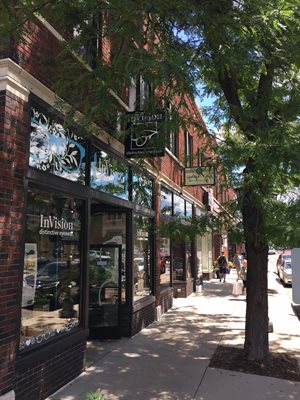 TOD design principles emphasize the pedestrian and creating a walkable environment that supports transit use. They apply to any area where cities want to minimize the impact of automobiles on the safety and desirability of walking. The most effective results come from applying these principles together, not separately.
TOD design principles emphasize the pedestrian and creating a walkable environment that supports transit use. They apply to any area where cities want to minimize the impact of automobiles on the safety and desirability of walking. The most effective results come from applying these principles together, not separately.
Sense of Enclosure for Pedestrians
One principle is that buildings should create a sense of enclosure for pedestrians. This is similar to the ways that walls create rooms and hallways providing order and a sense of security. To accomplish this, cities can establish minimum and maximum setbacks for new buildings, or they can prescribe “build-to” lines. Where a parcel faces two rights-of-way, the building should face both streets.
Buildings should be set back in ways that provide enough room for walking, streetscape, and outdoor furnishings like planters and sidewalk seating. For new development, cities should require that all off-street parking, as well as loading areas, be located behind or to the side of a building. Cities should limit the amount of street frontage that parking uses. Planners should also understand how streets and rights-of-way may change over time so that they can determine how development should relate to the street.
Uninterrupted Walking Routes
Another principle is that site plans for new developments should not conflict with primary walking routes. For the convenience of pedestrians, a building should include a main entrance that fronts, or is closely connected to, the sidewalk. For pedestrian safety, the number of driveways should be minimized and located on secondary streets rather than those designated as primary walking routes. Major building renovations and parking lot reconstruction provide opportunities for cities to apply TOD design principles.
Active Ground Floors
A third principle is that building uses on the ground floor should be “activated” along walking routes and within commercial districts. Activity on the ground floor of buildings serves a number of related purposes. Pedestrians can benefit from convenient retail or services. Active ground floors create a more visually engaging environment for pedestrians as they walk by. Finally, creating visual links between active ground floor uses and the sidewalk contributes to the safety of the pedestrian who may be alone on the street. Active ground floors could include lobbies, waiting areas, or other spaces that are used for gathering, meeting, or waiting.
Site Planning Along Transit
If development happens on streets that are served by Metro Transit, cities can consult with Metro Transit’s Urban Design group for feedback on how site plans might impact bus stops, transit customers, and bus operations (i.e., stopping, merging, turning, etc.). Metro Transit regularly reviews site plans with the City of Minneapolis, and Metro Transit encourages other cities to consult with us when planning development along transit routes or reviewing development prospects.
Resources:
We Can Help!
Site plans along Metro Transit routes
Carol Hejl, Landscape Architect
Metro Transit – Planning and Urban Design
[email protected]
612-349-7679